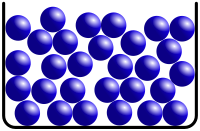
Photo from wikipedia
Abstract The network structure of GeO2 at 3500 K and under pressure of 0–100 GPa is investigated in terms of the short range order (SRO) and intermediate range order (IRO) by molecular… Click to show full abstract
Abstract The network structure of GeO2 at 3500 K and under pressure of 0–100 GPa is investigated in terms of the short range order (SRO) and intermediate range order (IRO) by molecular dynamics simulation. The results show that the structure of GeO2 consists of GeO4 tetrahedra that link to each other, forming a tetrahedral network. Under compression, there is a gradual transition from tetrahedral network to octahedral network (GeO6-network) via GeO5 polyhedra. At a certain pressure, the structure of GeO2 comprises three kinds of basic structural polyhedra: GeO4, GeO5 and GeO6. The spatial distribution of the basic structural polyhedra is not uniform, but they form clusters of GeO4-, GeO5- and GeO6-polyhedra. The size of the GeO5-cluster reaches the maximum at pressure of approximately 15–20 GPa (at density of approximately 4.95–5.25 g/cm3). The GeO5 cluster exists as an immediate configuration in the structural transition. At low pressure, most GeOx polyhedra (x = 4, 5, 6) link to each other by one common oxygen (corner-sharing bond). At high pressure, GeOx polyhedra link to each other by a corner-sharing, edge-sharing (two common oxygens) or/and face-sharing bond (three common oxygens). The Ge Ge bond length in a corner-sharing bond is much longer than that in edge-sharing and face-sharing bonds, and this is the origin of the first peak splitting of the Ge Ge pair RDF (Radial Distribution Function) under compression. At high pressure, the GeO5- and GeO6-polyhedra are dominant and tend to link each other through edge-sharing and face-sharing bonds, forming edge-sharing and face-sharing clusters. The size of edge-sharing and face-sharing clusters increases with increasing pressure, and this can be seen via the degree of the first peak splitting of the Ge Ge pair RDF.
Journal Title: Journal of Non-crystalline Solids
Year Published: 2017
Link to full text (if available)
Share on Social Media: Sign Up to like & get
recommendations!